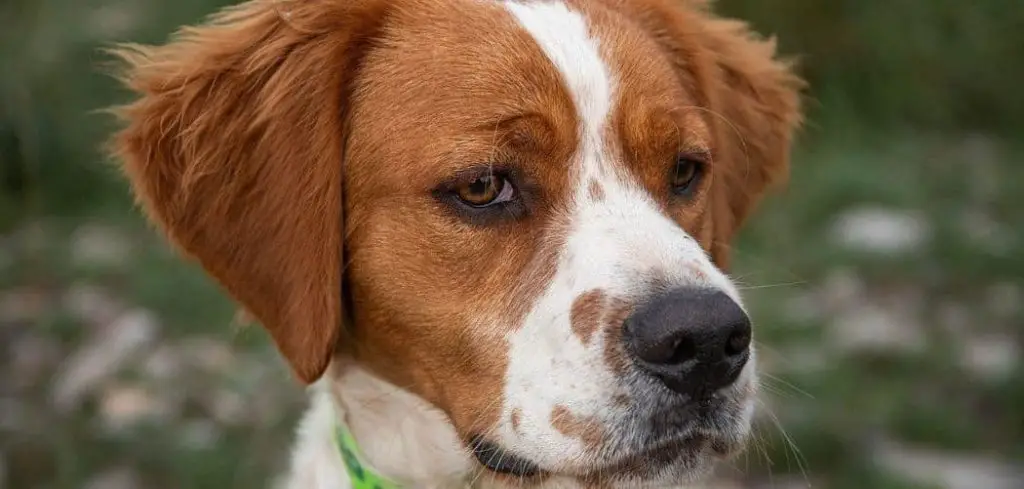If your dog is showing eye discharge and not eating, it’s a sign that something’s off—possibly more than just a minor irritation.
While eye discharge can happen occasionally from dust, allergies, or minor infection, it’s not normal when paired with loss of appetite.
That combination could mean your dog is feeling unwell or suffering from a more serious underlying condition.
We outline what causes a dog to have both eye discharge and appetite loss, what you can do at home, and when to call your vet.
Dog Eye Discharge and Not Eating: Why It Happens
A dog with eye discharge and not eating could be experiencing an eye infection, injury, systemic illness, respiratory infection, or even an autoimmune condition.
When the body fights off illness or deals with pain, the eyes may show irritation and the dog may avoid food due to nausea or discomfort.
These symptoms should always be taken seriously, especially if they develop suddenly or worsen over time.

Dog Eye Discharge and Not Eating: Common Causes
1. Eye Infections (Conjunctivitis)
Conjunctivitis is one of the most common reasons for eye discharge in dogs.
It can be caused by bacteria, viruses, or allergens. Infected eyes often appear red, swollen, and produce thick yellow or green mucus.
The irritation can be painful enough to reduce your dog’s appetite, especially if they’re also feeling run-down or feverish.
If both eyes are affected or your dog is squinting constantly, medical treatment is necessary.
2. Upper Respiratory Infections
Much like in humans, a cold or respiratory infection in dogs can cause eye discharge, nasal congestion, sneezing, and a loss of appetite.
These infections may be viral or bacterial and are especially common in dogs recently exposed to kennels, shelters, or dog parks.
When breathing is difficult or the sense of smell is impaired, dogs may refuse food altogether.
Eye symptoms often accompany these upper respiratory issues.
Related: Dog vomiting and not eating (Causes and when to worry)
3. Eye Injury or Foreign Object
A scratch on the eye or a foreign object (like a seed, hair, or piece of debris) can cause intense discomfort and lead to eye discharge.
If your dog’s eye appears cloudy, excessively teary, or half-closed, injury is a possibility.
Dogs in pain often avoid eating, especially if chewing or moving their head causes additional strain.
Sudden-onset symptoms and behavioral changes usually indicate trauma.
4. Corneal Ulcer or Glaucoma
Both corneal ulcers and glaucoma cause significant eye discomfort and discharge.
These conditions are more serious and require immediate veterinary attention.
Dogs with ulcers may rub at the eye constantly and keep it shut, while glaucoma often causes bulging, redness, and watery or thick discharge.
Loss of appetite typically follows as the pain and pressure intensify.
5. Systemic Infection or Fever
Some diseases, such as canine distemper, tick-borne illnesses, or leptospirosis, can cause both eye discharge and lack of appetite.
These conditions affect multiple systems in the body and may include symptoms like lethargy, vomiting, nasal discharge, or coughing.
In some cases, eye inflammation (uveitis) is a secondary response to an internal infection or immune reaction.
Related: Dog vomiting water and not eating (What it means)
6. Allergies or Environmental Irritants
Allergies to pollen, mold, household cleaners, or food ingredients can result in red, watery, or gooey eyes.
While many dogs continue to eat despite mild allergic reactions, some become nauseated or uncomfortable enough to avoid food.
Environmental allergies often cause itchiness, paw licking, and sneezing alongside eye symptoms.
7. Dental Disease or Oral Pain
Although it may seem unrelated, oral pain can sometimes lead to eye discharge, especially in small breeds.
Tooth root abscesses in the upper jaw can affect the tissues near the eye socket, causing swelling and discharge.
Dogs may avoid food because chewing is painful, and they might also show facial swelling or foul breath.
Related: Dog eye discharge and not eating and lethargic (What it means)
What to Do If Your Dog Has Eye Discharge and Won’t Eat
If the symptoms are mild and your dog seems otherwise stable, you can try these steps at home while monitoring closely:
Clean the eyes gently with warm, damp gauze or a saline solution to remove discharge.
Check for debris or swelling around the eye area, but avoid touching the eye itself.
Offer soft, bland food like boiled chicken and rice to tempt your dog to eat.
Use a cone (e-collar) if your dog is rubbing or scratching their eye to prevent further injury.
Keep your dog calm and indoors, avoiding bright light or windy conditions.
However, do not wait long. If the symptoms don’t improve within 12–24 hours—or worsen—seek veterinary care.
When to Call or Visit Your Vet
Call your vet right away if:
Eye discharge is thick, green, yellow, or foul-smelling.
Your dog refuses all food for more than 24 hours.
One or both eyes are red, swollen, or held shut.
Your dog is squinting, pawing at the eye, or yelping when touched.
Additional symptoms appear, such as vomiting, lethargy, or nasal discharge.
Your dog shows signs of a possible injury or has been in a dog fight or dusty environment.
A veterinary exam will help determine whether your dog needs antibiotic eye drops, pain relief, imaging, or further diagnostics for an internal condition.
Related: Dog eye discharge and not eating and vomiting (What it means)
Key Takeaway
When your dog has eye discharge and is not eating, it’s often more than a minor annoyance.
These symptoms together suggest your dog is uncomfortable, possibly in pain, and dealing with more than just irritated eyes.
Whether it’s an eye infection, systemic illness, or oral pain radiating toward the eye, prompt action is essential.
Always trust your gut. If your dog doesn’t seem like themselves—especially if they’re avoiding food and showing discomfort—it’s time to check in with your vet.
The sooner you act, the quicker your dog can get relief and get back to feeling their best.
